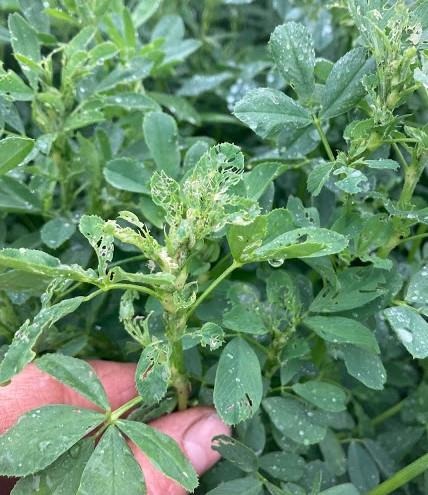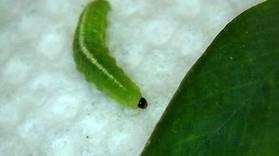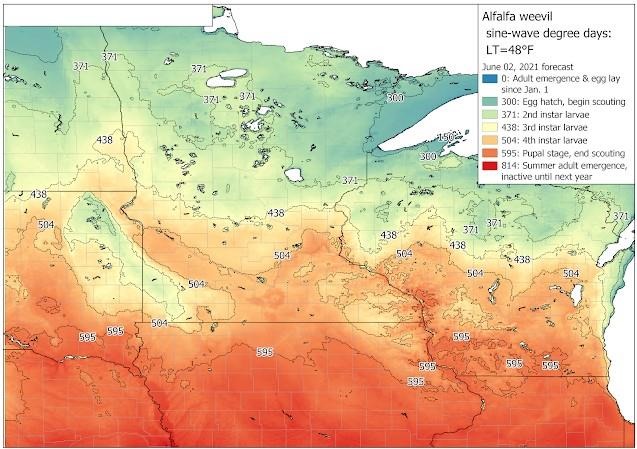 |
| Figure 1. Skeletonized leaves from larval feeding. Photo: Jared Goplen |
 |
| Figure 2. Alfalfa weevil larvae can be distinguished from other weevil species by the black head capsule. Photo: Anthony Hanson. |
Similar to crop development, alfalfa weevil development, especially prediction of when larval stages are occurring, can be estimated using degree-days. Forecast maps to help gauge when scouting should occur are currently available at: https://vegedge.umn.edu/degree-days-midwest-insects/alfalfa-weevil. Once larvae develop into pupae, they are no longer causing feeding damage, and newly developed adults enter a summer dormancy. These adults will be present in fields, but will not be laying eggs until the following year, so economic damage from alfalfa weevil ends when larvae are no longer present. This damage window typically coincides with the end of first cutting and the start of regrowth for the second cutting.
As of May 27, some egg-laying adults are still present (Fig. 3). Larvae have recently hatched or are in early instars in the southern half of Minnesota. Based on current weather forecasts, larvae should be reaching the pupal stage in northern Iowa around June 2 (Fig. 4), so larval presence in Minnesota should also be declining in early June. Finding adults in spring does not always mean large numbers of larvae will be present later. Likewise, the correct timing for the damaging larval stage does not guarantee populations will be high enough to cause significant damage either. Adults have been found in fields in central and west-central Minnesota, and larvae have been found causing noticeable feeding damage in some fields. There have been reports of prominent skeletonized fields in surrounding states, so monitoring should continue for larvae in Minnesota.
 |
| Figure 3. Current degree-days as of May 27, 2021. |
 |
| Figure 4. Forecast degree-days for June 2, 2021. |
Scouting and management
Scouting should occur in mid-May through June by using a sweep net to determine if larvae are present. If present and easily found in sweeps, select and cut 30 plants across the field at ground level. Record each plant’s height and shake in a 5-gallon bucket to determine average number of larvae per stem in the field and if weevil counts exceed economic thresholds (Table 1).
Table 1. Economic thresholds for alfalfa weevil based on hay value.
| | | Hay value ($/ton) |
| | Treatment | $50 | $75 | $100 | $125 | $150 | $175 |
Stem height | cost/acre | Average larvae per stem |
10-15 inches
(mid-vegetative) | $7
$8
$9
$10
$11
$12 | 3.6
4.1
4.7
5.3
5.9
6.4 | 2.2
2.6
3.0
3.4
3.7
4.1 | 1.5
1.8
2.1
2.4
2.7
3.0 | 1.1
1.4
1.6
1.8
2.1
2.3 | 0.9
1.1
1.2
1.4
1.6
1.8 | 0.7
0.8
1.0
1.2
1.3
1.5 |
16-20 inches
(late vegetative) | $7
$8
$9
$10
$11
$12 | 3.8
4.4
4.9
5.5
6.1
6.7 | 2.4
2.8
3.2
3.6
4.0
4.4 | 1.8
2.1
2.4
2.6
2.9
3.2 | 1.4
1.6
1.8
2.1
2.3
2.5 | 1.1
1.3
1.5
1.7
1.9
2.1 | 0.9
1.1
1.2
1.4
1.6
1.7 |
>20 inches*
(early bud) | $7
$8
$9
$10
$11
$12 | 4.0
4.6
5.2
5.8
6.3
6.9 | 2.7
3.1
3.5
3.8
4.2
4.6 | 2.0
2.3
2.6
2.9
3.2
3.5 | 1.6
1.8
2.1
2.3
2.5
2.8 | 1.3
1.5
1.7
1.9
2.1
2.3 | 1.2
1.3
1.5
1.6
1.8
2.0 |
*If >50% of plants are at bud stage, it's more beneficial to mow. |
Most damage occurs around late first cutting and occasionally in second cutting regrowth, so the likelihood of a return on investment from insecticide application after the first cutting of the year is often reduced. This is in part because mowing, crimping, and exposure from lack of cover kills most larvae from regular harvest. Early mowing, if feasible, can also control alfalfa weevil to some degree in place of insecticide if thresholds are reached, especially when considering any pre-harvest intervals for insecticide use. However, damage from alfalfa weevil and other insects, such as variegated cutworm, can still occur under windrows where larvae are protected. This damage is most pronounced when hay cannot be baled shortly after mowing. Because of protected larvae and unhatched eggs, growers should plan to scout at least once after the first cutting.
Alfalfa weevil is typically the first pest insecticides may be used for in alfalfa during the year. Insecticides labeled for alfalfa weevil include pyrethroids and organophosphates. Parasitoid wasps and other natural enemies help suppress alfalfa pest populations, but they are also susceptible to these insecticides, so flare-ups of alfalfa weevil or other pests such as pea aphid can occur after treatment. Weevil adults can remain in fields feeding throughout the summer, though they generally do not cause economic damage. However, this also means they can be exposed to insecticides used for later-season pests, such as potato leafhopper. In addition to further reducing natural enemy populations, multiple applications in a field can also increase the likelihood of alfalfa weevil becoming resistant to those insecticides, which further illustrates the need for careful use of currently available control options.
As an attractive crop to pollinators when in bloom, following threshold and integrated pest management recommendations for alfalfa can also act as protection for pollinators. If a field is near bloom stage, it is often too late for an insecticide application, but mowing followed by scouting can often provide the most economical decision as well as avoid risking application when pollinators would be attracted to the field.
Source : umn.edu